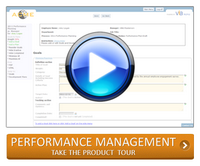Talent Management Strategies to Combat the Global Talent Crisis
Goals for 2012 are set and everyone is moving forward in the same direction (*fingers crossed*). So, let us now shift our focus to the development planning aspects of
 employee performance management. Development planning is often tabled while we are following our marching orders towards goal execution. In reality, we no longer have this luxury.
employee performance management. Development planning is often tabled while we are following our marching orders towards goal execution. In reality, we no longer have this luxury.
Despite the economic downturn, all evidence points to an impending Global Talent Crisis. Such a talent shortage demands that organizational leaders prioritize talent and skills development now. This will increase the engagement of talented employees by facilitating career-oriented growth at the company, as well as minimize the predicted talent gaps the organization will face in the near future.
Indoctrinating our talent with the essential competencies and skills that are necessary for current and future job growth is essential to talent management initiatives and a top-priority for Human Resources in 2012. Employee performance management is a key part of this talent initiative, in that managers must work collaboratively with their team members to identify career objectives and related growth and development opportunities.
Below are some tips:
Prepare Managers for career/development discussions.
Managers may feel uncomfortable discussing career aspirations with team members if they are not familiar with the possibilities for advancement, nor do they understand the talent strategy around career progression within the organization. As HR leaders, we can help functional leaders to outline the organization’s career path framework, as well as to highlight the various ways that employee’s can move throughout the company. Communications should also focus on development planning as it relates to the overall performance and talent management strategy. This will provide Managers with a platform for opening career-related discussions, as well as ready their response to the question “Where do you want to be in 5 years?”
Identify knowledge/skills gaps.
Employees and Managers should work collaboratively to identify gaps in current knowledge/skills as compared with those that will potentially be required for future roles. Be sure to advise Managers to look across the career path framework for lateral moves in addition to advancement opportunities. Once the knowledge/skill areas have been identified, the Employee and his/her Manager can work together to create development plans that progressively target skill building in these areas.
Align performance goals and development planning.
Managers should work with employees to ensure that each development plan - related to the overall career objective - is in line with specific performance goals that require him/her to utilize key skills/competencies. This will ensure the employee is immediately focused on building those skills/competencies that are most relevant to future positions and growth opportunities. Because the employee may not yet have fully developed the skills/competencies necessary for successful completion of these stretch goals, the success criteria may need to be slightly modified.
Offer follow-up and support.
Managers frequently check-in on and adjust performance goals with their employees. Development and career plans should be updated in a similar manner. Because career plans are so high level and unlikely to change very frequently, Managers should focus on reviewing the individual development plans that support the overarching career objectives and make adjustments as necessary. To foster a culture of continuous learning and development, the organization should readily offer the necessary resources for knowledge/skills development. Going even further, employees must be allowed to test their developing knowledge/skills in real, on-the-job scenarios while receiving support from mentors/Managers.
With the fast approaching talent shortage, organizations that prioritize developing their talent and collaborating with team members to identify a specific career path within the company will better engage and retain their engaged workforce. The talent wars will only get worse over time; organizations who are investing in top talent and giving employees a roadmap for growth and success within the organization will better weather this storm.
See for yourself how viaPeople's Performance Management solution can help you weather the talent storm.
Share this
You May Also Like
These Related Stories

Performance Calibration vs. Talent Calibration: Do You Need Both?

Using Development Goal Setting to drive performance.


